Movie Review By: SFAM
Year: 1994
Directed by: Peter Hyams
Written by: Mike Richardson & Mark Verheiden
IMDB Reference
Degree of Cyberpunk Visuals: Medium
Correlation to Cyberpunk Themes: Medium
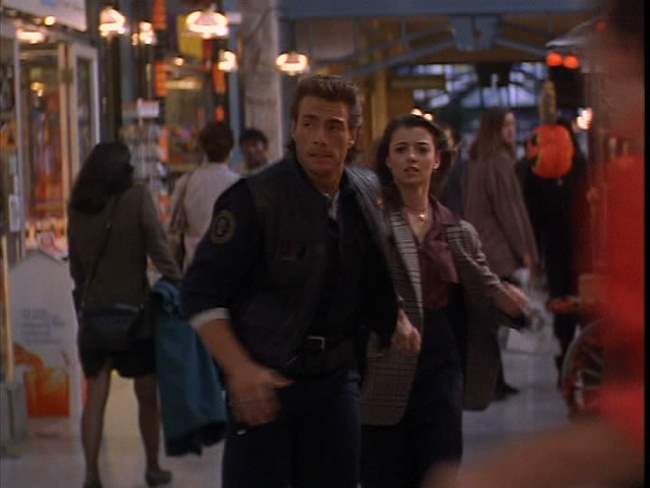
Overview: In the annals of cheesy time travel movies, few are known better than Timecop, which cleared over 100 million in world wide box office gross. Starring martial arts star, Jean-Claude Van Damme, Timecop has decent but low-budget FX, a fairly shallow notion of science and time quandaries, but does provide a face-paced cyberpunk action-thriller with decent amounts of butt-kicking and gun fighting. Like many of his movies, Van Damme plays more than one version of himself – in this case, he plays himself 10 years into the future.
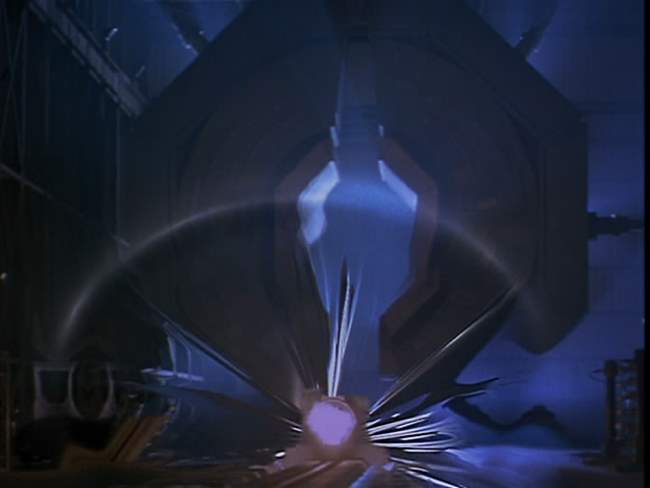
The Story: In the near future (2004), time travel has now become possible. Unfortunately, there is a very real danger that going back in time will alter the present. To protect against potential abuse, a special police outfit called the “Time Enforcement Commission” is established to monitor and enforce time travel concerns. Max Walker (Van Damme) is selected for an interview to join. Unfortunately, events in the future have already changed his current circumstances, which lead to the death of his wife, Melissa (Mia Sara).
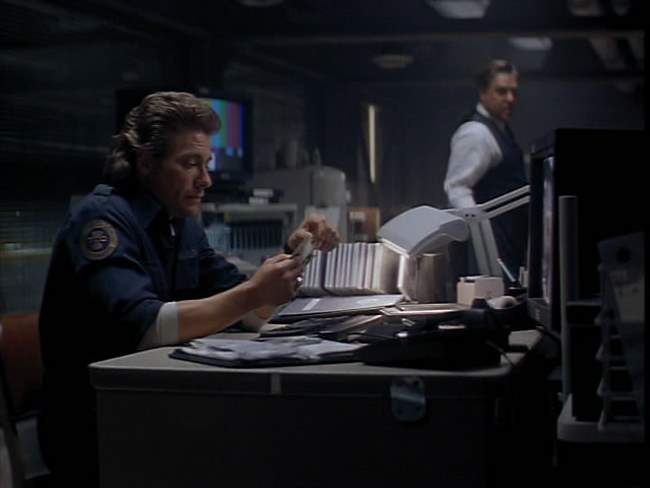
Ten years into the future, Max, still working at the Time Enforcement Commission, goes back in time to stop his former partner from attempting to splurge on low-price stocks in 1929 that will be worth a fortune in the future. In stopping his partner, Max uncovers a larger plot of time travel tampering that implicates a sitting Senator of the United States (Ron Silver). As Max starts to investigate, the bad guys begin significant tampering with the timeline. Upon return from one of Max’s fact finding trips, he sees that the future has been significantly altered, and the police force is being decommissioned.
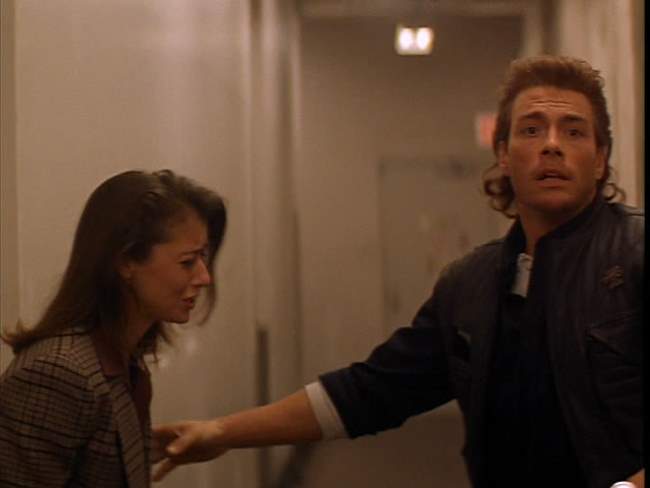
Max convinces his former friend (the time altering apparently has affected their friendship) and police Commander, Eugene (Bruce McGill), to send him back in time to fix the damage done to the timeline. In doing so, Max has an opportunity to go back and save his wife. Things come to a head when Max and the Senator meet face to face (both current and future versions of each).
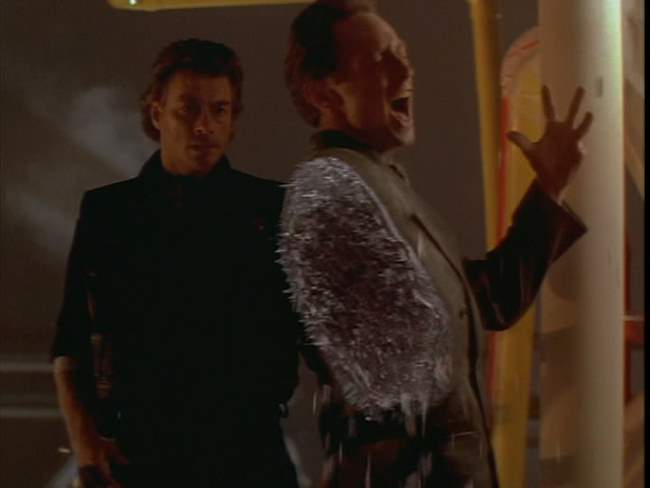
The Action: The reason you want to watch Timecop is primarily for the fast-paced action sequences. We get lots of Van Damme kicking, along with a nice smattering of gunfights, all in interesting locations. As a downside, only one or two of the bad guys put up a decent fight. So many of the action scenes involve Van Damme just wailing on “red shirt” henchmen.

The FX: The FX for Time Cop worked at the time, but now look somewhat dated. There are quite a number of time portal effects, along with a few burning and “people plasma” shots sprinkled throughout. The set designs are pretty decent, most notably the time portal device, which has a nice dirty, low-tech feel to it. Still, I wish they had done more with the time travel machine, which looks and works like a rocket version of Back to the Future’s flux capacitor.
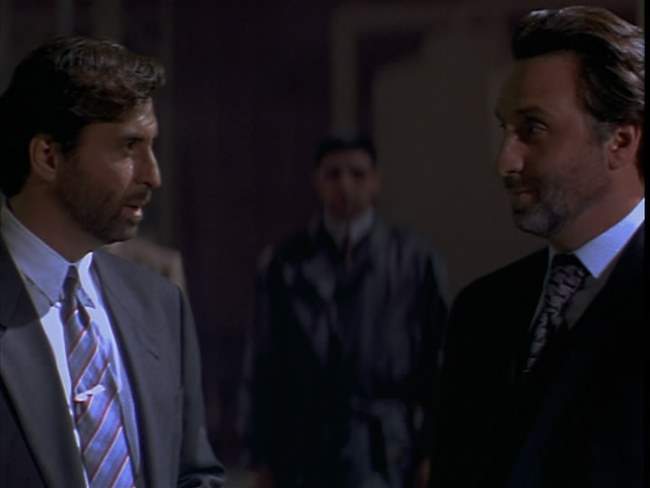
The Acting: Considering this is a Van Damme movie, the acting is somewhat better than expected. Van Damme is his same self, which is to say “rather wooden.” But Mia Sara, Ron Silver and Bruce McGill turn in decent performances – certainly decent enough to work with the fast pacing.
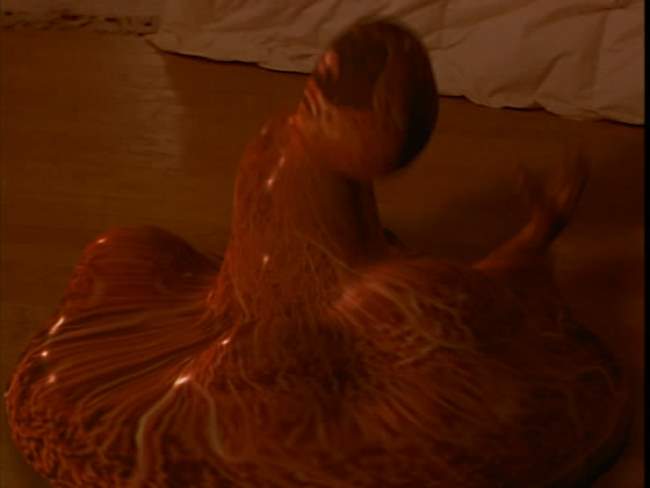
Problems with Time: Timecop really can’t be used to spark interesting discussions on time travel. The questions with how and why things work are too numerous and problematic to engage in interesting discussions. Somehow, they are able to determine if someone has violated time, and can go and stop them, but they don’t seem to be able to go to the same place more than once – why? The same two people cannot occupy the same space – why? What happens if a guy is 80 years older and goes back an visits himself as a small child? Virtually none of the same cells will remain from the child – certainly no skin cells (nor would they for 10 years out, as was the case for the poor Senator) – so how does this constitute occupying the same space? When Max Walker spends the day jumping through time, the future is modified – and he seems to have lost 10 years worth of memories. What happened to the version of Max that lived those 10 years? Did he disappear, or has he simply not gotten home from work yet? One gets the sense that Max is just jumping alternate versions of the present – each one that he created – but the ideas are too shallow to make any real sense of this.
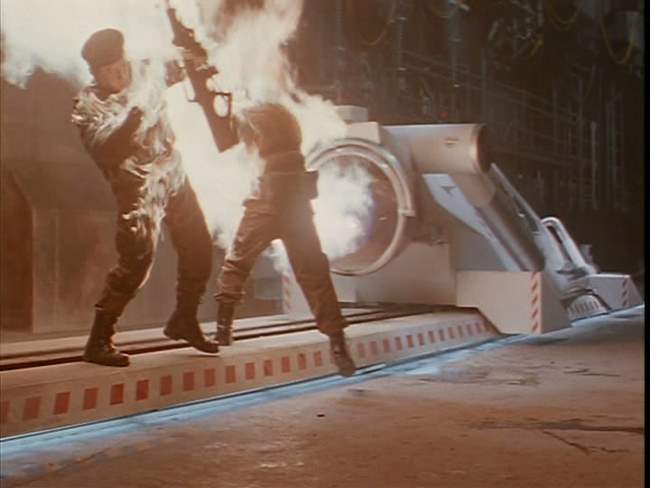
Bad Guys Have Limited Imagination: Like many bad guys, the imagination of the evil doers in Timecop is severely limited. Time travel is used to go back and engage in bank heists, make stock purchases that pay out 70 years in the future, and so forth. If one really had this technology cornered, it seems that there would be far better ways to generate income. With just an ounce of imagination, one could come up with a myriad of more interesting ways of generating power and influence than petty crime. What about a recorded interview with Jesus Christ? One would think this might generate lots more power and income than knocking off a confederate wagon train shipping small quantities of gold. Instead, the extent of Senator McComb’s ambition is to get rich, kill off potential enemies and then steal the presidential election.
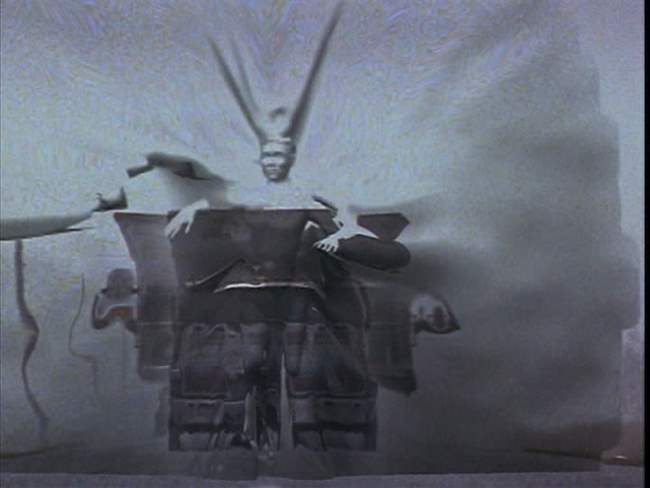
The Bottom Line: Timecop is an enjoyable movie assuming you turn your brain off prior to watching. This approach generally works as the fast-paced nature of the movie serves to stop you from noticing too many issues. The action is good and the FX are passable, so if you want to kick back and enjoy some Hollywood martial arts wrapped up in a cyberpunk time travel flick, give it a go. I will say though that the quality of the DVD is horrid - so much so that I’m docking a star from my review. It’s got a lousy transfer, no extras, and is in full screen only. Common Universal – fix this!
~See movies similar to this one~
Movie Review By: SFAM
Year: 1966
Directed by: Franklin Adreon
Written by: Arthur C. Pierce
IMDB Reference
Degree of Cyberpunk Visuals: Low
Correlation to Cyberpunk Themes: High
Key Cast Members:
Gareth A7: Michael Rennie
Dr. Karen Mason: Karen Steele
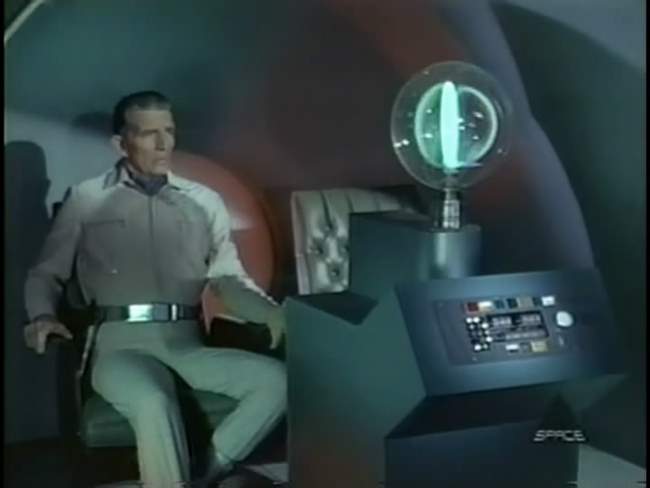
Overview: On its face, Cyborg 2087 sounds like the plot for the terminator: this guy from a dystopic future comes back to the past to stop the development of a new technology with lots of promise, that ends up destroying humanity as we know it; unfortunately, he is chased by these cyborg things who are bent on stopping him. While there are certainly some similarities, the differences are perhaps broader. Aside from the obvious budget differences, the plot in Cyborg 2087 involves a cyborg returning from the future versus a man, and he’s not trying to perform a “retroactive abortion,” he is doing something similar to Sarah Conner in T2 – he wants to stop the technology from being released at that time.
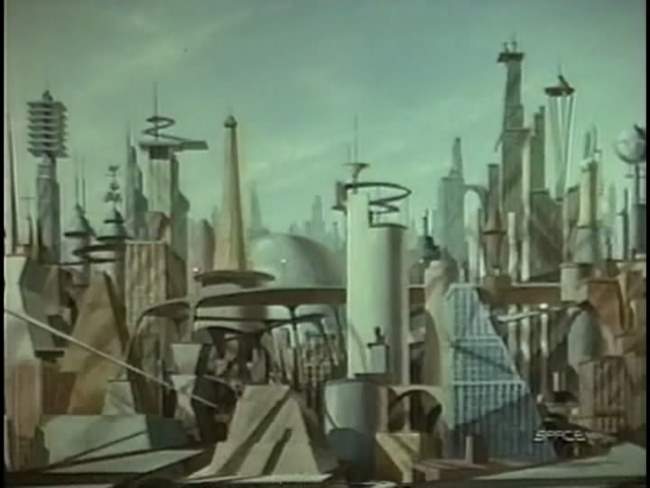
The Story Genius scientist Professor Sigmund Marx has created a technology that allows us to guide other people and influence their thoughts. Unfortunately, it turns out that this technology will be subverted by the government and military to engage in mass thought control of the population. In the future, humanity’s freewill has been crushed. Now a race of cyborgs have taken control to maintain stability. A small group of freedom fighters has come upon a method for restoring humanity. They have created a time machine, and intend to send back a cyborg who has had his “control” chip removed – the goal of which is to convince Professor Marx to abandon his experiment, or in worse case, to kill him.

The cyborg, Gareth A7 (played by Michael Rennie of Day the Earth Stood Still), doesn’t have access to all his technology when he was sent back. Worse, he has a homing beacon implanted in him that will lead the killer cyborgs, called tracers, right to him. He happens upon Professor Marx’s assistant, Dr. Sharon Mason (Karen Steele), and uses the perfected form of Marx’s technology to overwhelm her freewill and force her to assist him. From there it’s a race. The bad cyborgs from the future have arrived and are sporting killer ray guns. Gareth and Sharon must find the professor and convince him prior to the killer cyborgs finding him.
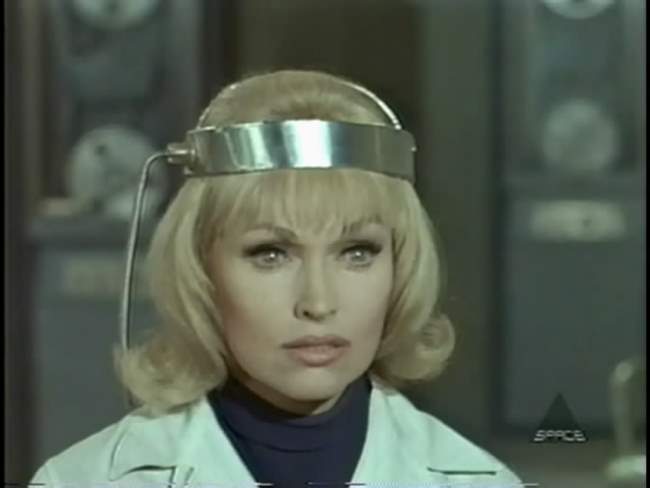
The Acting: The acting in Cyborg 2087 is fairly sub par. Aside from Michael Rennie, who I just enjoy seeing in another flick, the rest of the cast really falls short. Karen Steele over-emotes, as does her secondary love interest, Harey Carey Jr. The tracers are particularly bad, as are most of the bit characters. The Sheriff, played by Wendell Corey, while over the top, is at least well done. The bottom line here, with a budget as low as this one was, the only way Cyborg 2087 could have worked is if the acting paid off – unfortunately it didn’t.
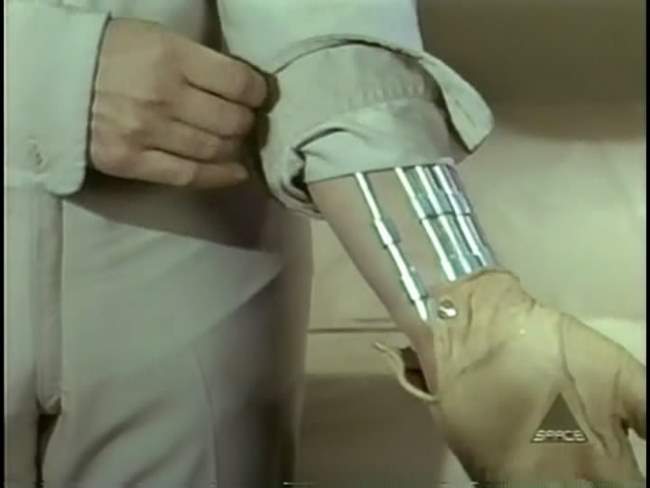
The FX: Cyborg 2087 is very low budget, so we can’t expect much in the way of realistic effects. The extent of fanciness here involves making something disappear by taking another shot with the object removed. The ray guns have the cheesy thick white light look, and the outfits are anything but high tech. The opening shot of the futuristic city, which is nothing more than a painting, is at least interesting from the standpoint that it shows you what people in the sixties thought our futuristic cities would look like. At best, Cyborg 2087 tries for the cyberpunk western look, but this too is problematic. Perhaps the worst part of the FX deals with the tracers, who are heavyset guys running around in fake US army costumes. They really coulda spent at least a buck or two to buy an extra who at least was in shape. On top of this, the cartoonish sounding score is especially atrocious. If there were any quality scenes in this movie, the score ensures that they won’t be noticed.
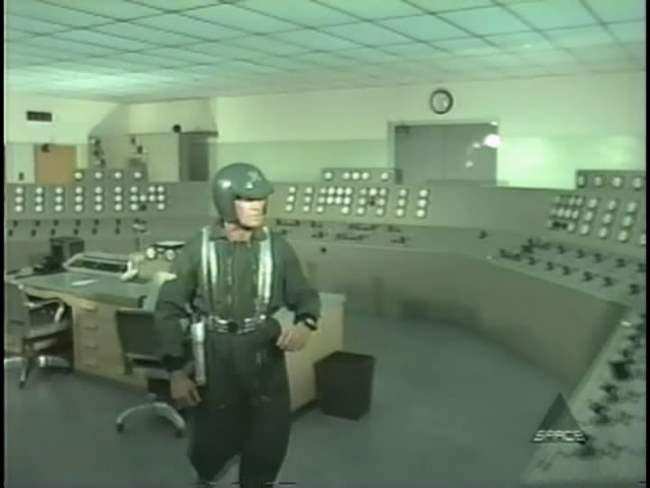
Cyborgs: In Cyborg 2087, we are told that the cyborgs are a combination of man and machine, but we really don’t get much more of a breakdown than that. We know that they have wide open spaces in their bodies, and that they have the power of five or six men. Basically, the model we get here is of regular people that basically work like simple computers, and are able to have various computer chips embedded in them. In the end, its not a very believable view of cyborgs, and isn’t even a consistent one. We are told that cyborgs have no emotion, but somehow, Gareth falls in love with Sharon. The movie would have worked so much better had he let her die near the end versus what did happen (the heroic rescue).
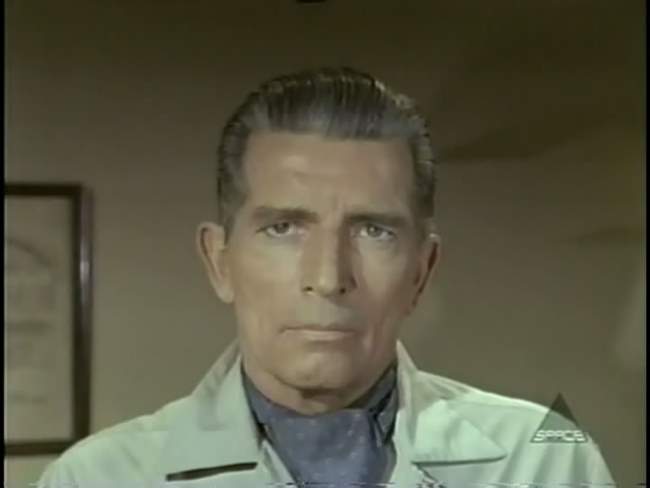
The Bottom Line: Arthur Pierce’s script for Cyborg 2087 probably mostly decent (aside for the Hollywood happy ending factor), but unfortunately Franklin Adreon’s directing talents are not enough to bring it to a successful fruition. Far too frequently, Cyborg 2087 comes across as poorly done SciFi cheese. Again, had the acting been decent, one could easily overlook the low-qual FX. Unfortunately this is not the case. However, I did find it worthwhile to watch for one reason only – I loved Michael Rennie in the Day the Earth Stood Still, and really enjoyed seeing him in another flick. His acting is pretty much the same (Stoic, serious, impending doom looking demeanor), but at least we get to see him running around and performing action scenes.
~See movies similar to this one~
Movie Review By: SFAM
Year: 1980
Directed by: Fred Barzyk & David R. Loxton
Written by: Diane English & Roger Swaybill (script), Ursula K. Le Guin (novel)
IMDB Reference
Degree of Cyberpunk Visuals: Low
Correlation to Cyberpunk Themes: Medium
Key Cast Members:
George Orr: Bruce Davison
Dr. William Haber: Kevin Conway
Heather LeLache: Margaret Avery
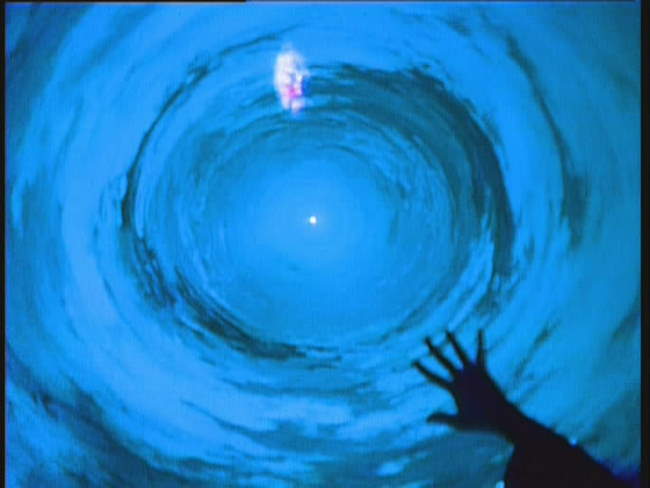
Overview: Lathe of Heaven is one of the classic SciFi books by Ursula K. Leguin. The 1980 adaptation (unlike the 2002 version) stays pretty faithful to the book, and is a very well done low-budget made-for-TV movie. Unfortunately, the original master was lost, so the DVD transfer was taken from a VCR recording of the 1980 TV broadcast. The quality isn’t great, but the story more than makes up for it. Lathe of Heaven is as symbolic as much as it is a narrative. Overall, the film provides an immersive experience with a truly interesting ending.
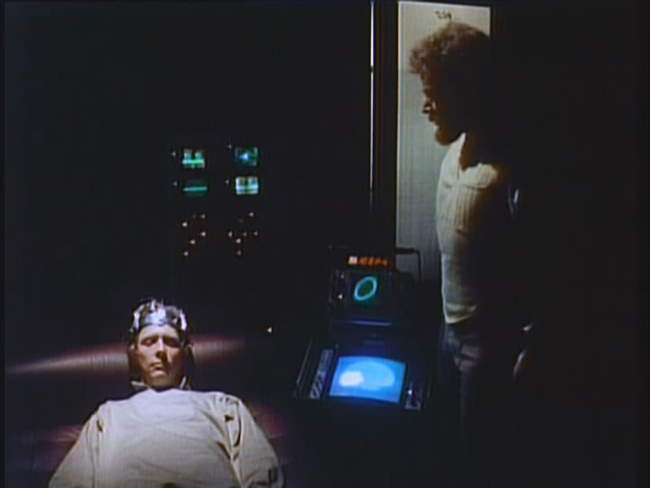
The Story: Thirty years into the future, the world has been decimated by a nuclear holocaust. George Orr (Bruce Davidson), having just been exposed to massive radiation lays dying. Somehow his body is changed, and he has the power to “dream” the world back into existence, just as it was, but without the nuclear holocaust. He forgets that this has occurred and tries to live his life normally, but is continually plagued by dreams that can effect changes in reality. In this dystopic, controlling future, he is forced to undergo psychiatric therapy, and is assigned to Dr. Haber, an expert in dream problems. George is looking for Dr. Haber to “cure” him, but Haber has other ideas.
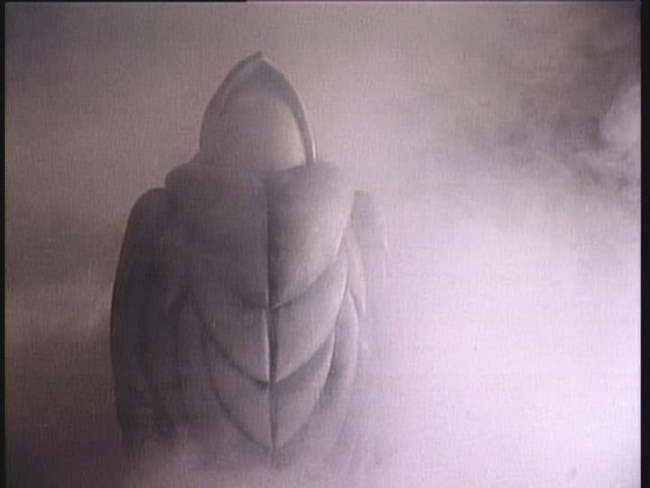
Dr. Haber quickly realizes that George is not crazy, but in fact possesses the most powerful gift ever given to man. Haber sees this as an opportunity to reshape the humanity and the world itself to become the ideal place that Man has always intended. Haber, using his dream-enhancement technology, asks George to have an effective dream about removing pollution. George does, but ends up removing all clouds, leaving the earth ever increasingly hot and dry. Haber forces George to dream of a way to cure overpopulation – this results in a plague that kills of 75% of the world’s population. Haber forces George to dream of peace on earth which results in an alien invasion that unites humanity but which can lead to the destruction of the earth itself.
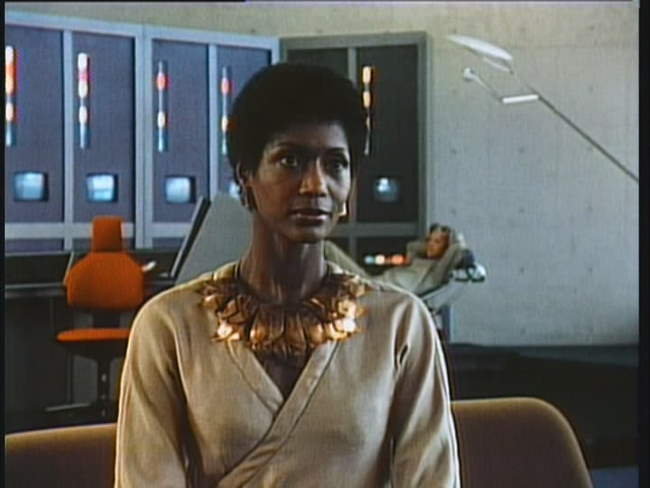
Even though Haber feigns ignorance of what’s really occurring, George quickly figures out that Haber is using him. Unfortunately, George doesn’t have the force of will to truly confront Haber. Instead, he enlists the services of a lawyer named Heather (Margaret Avery) to help get his psychiatrist changed to someone other than Haber. Unfortunately, when Heather goes to visit a session, it is already too late, as George’s effective dream has just killed off 75% of the world’s population.
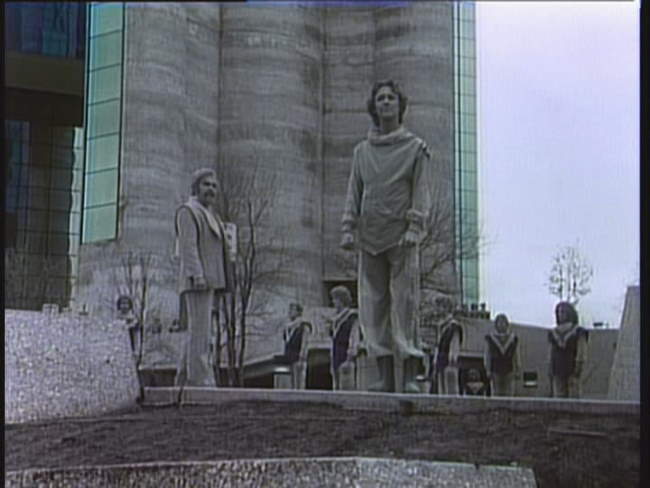
This pattern of George leaving, and returning continues, finally resulting in Haber forcing George to dream of removing racism (which results in everyone becoming gray) – Haber’s real purpose is to capture and duplicate George’s powers through his dream machines. Haber decides that the maladies are caused by inadequacies in George, and that he, an enlightened scientist will be able to have pure dreams that will result in the betterment of mankind. Unfortunately, when Haber dreams an effective dream, his results in a dream that will “unmake” reality. Only George can come and try to challenge Haber to a test of wills to bring a semblance of reality back.

Taosim versus Positivism: Lathe of Heaven sets up a dual between a Taoist philosophy of participation versus a positivistic one. George Orr, representing the Taoist philosophy, is perfectly willing to let the world take its own course. Even though he has the power to change the course of humanity, he prefers to go with the flow, and understands that overt and specific changes to a very complex and interdependent world will result in disaster. Dr. Haber represents the positivist view, and sees technological advancement as the primary means of improving the human condition – moreso, he believes his duty as a scientist is to utilize George’s gift to transform the world for the better. After experiencing a series of continually worse impacts to the world when forcing George to use his power, Haber finally decides the problem is with George’s unconsciousness. It never occurs to him that the real danger is in converting George’s power to a technology that can transform reality.
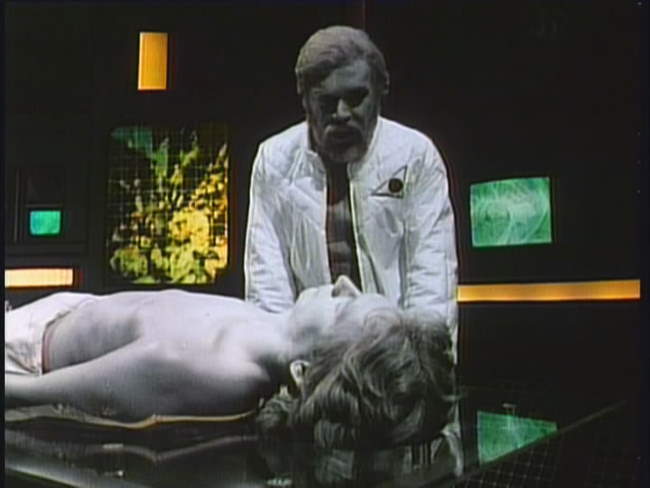
Le Guin’s message is clear: incredible power, especially augmented by technology, cannot be used in a simplistic way to transform a reality which is complex and intertwined. Instead, those interested in change must “go with the flow” of reality and change the human condition within the context of there normal interaction. The use of dominating power over nature will result and a dystopic future. This is in fact what Lathe of Heaven portrays.
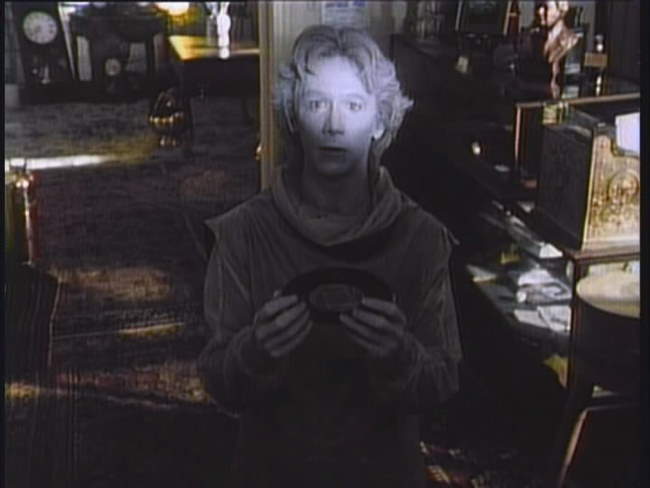
Is Lathe of Heaven Cyberpunk? I do agree that Lathe of Heaven at best is a cyberpunk fantasy. I include it here primarily due to the use of technology, invented for the purpose of human betterment, that ends up instead almost destroying humanity. Haber’s dream enhancement technology results in increasing George’s capabilities, and ultimately leads a true cyberpunked future. Human diversity is quashed when everyone left alive (after the plague kills over 75% of the population) turns gray. Individuality is suppressed in an attempt to eliminate conflict. In the end, the message is a similar cyberpunk theme – the use of technology to remake the perfect society results in a dehumanized, sanitized dystopia.

The Bottom Line: Although low budget, the Lathe of Heaven is effective in transforming a very philosophical book to a motivating film. The dual of Taoism versus positivism is mirrored in the colors, where the Taoist earth tones dual the technological grays and whites. The three leads deliver quality performances, and the story itself is captivating. While some of the FX are suspect, and the quality of the DVD is poor (the original master was lost), Lathe of Heaven is well worth a watch.
~See movies similar to this one~
Movie Review By: SFAM
Year: 2002
Directed by: Steven Spielberg
Written by: Philip K. Dick (short story), Scott Frank & Jon Cohen (screenplay)
IMDB Reference
Degree of Cyberpunk Visuals: High
Correlation to Cyberpunk Themes: Medium
Key Cast Members:
Chief John Anderton: Tom Cruise
Pre-Crime Director Lamar Burgess: Max von Sydow
Agatha: Samantha Morton
Danny Witwer: Collin Ferrel
Evanna (John’s Wife): Jessica Capshaw
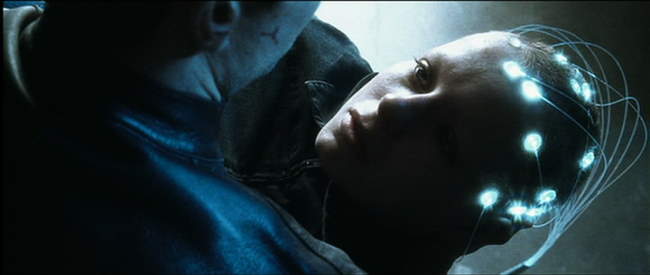
Overview: Minority Report, directed by Steven Spielberg, is another one of the large scale production cyberpunk movies that cleared a hefty gross (358 million worldwide, not counting DVD sales). Minority Report works both as a summer blockbuster (it was released in June), but also as a fairly intelligent cyberpunk flick. Based on another terrific story from Phillip K. Dick, Minority Report has a terrific cast headed up by Tom Cruise and Max Von Sydow, awesome special effects, and terrific music and sound FX throughout.
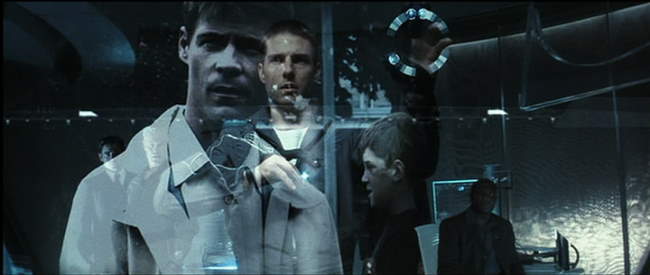
The Story: In Minority Report, Tom Cruise stars as John Anderton, a police chief at the head of an elite pilot police program, now in its sixth year, that prevents crimes BEFORE they are committed. The year is 2054, and the ability now exists within gifted, but altered people called “precogs” to tell when someone is about to commit a crime. The Precogs, comprised of two twins and one woman, Agatha (played wonderfully by Samantha Morton), are kept at all times in a dreamlike state in strange pool of water. The Precogs receive visions of murders that will be taking place. Based on an elaborate system that works off the Precogs, the police are able to extract the visions and are given the names of the murder victim and the murderer on color coded balls. Based on this, all premeditated murders have become a thing of the past – now the only murders that “might” take place are the crimes of passion, or “red balls” in Minority Report terms. When a red ball comes, the John Anderton must quickly work with the dreams to find the location of the murder (which often is only a few minutes or hours into the future) so that his team can rush to prevent it.
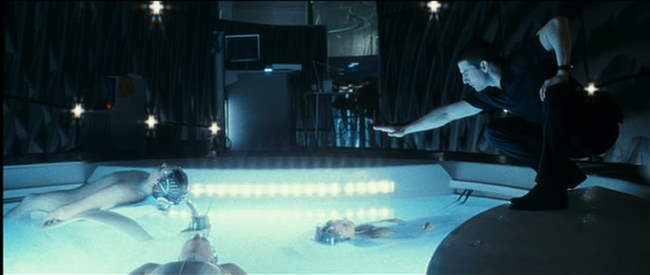
The end result of this technology is that people are being imprisoned for the crime PRIOR to committing it. Those who are identified by the Precogs are immediately sentenced to a strange virtual prison, where they are stuck in perpetual dreamstate (no word is given why they aren’t relegated to a normal prison). Through a quirky situation, John Anderton is brought in close proximity to the Precog, Agatha – she grabs him and fervently relays a vision that has occurred in the past. In tracking this down, John Anderton learns that sometimes one of the three Precogs actually deliver a vision that differs from the other two. This vision, termed a “Minority Report” is quickly discarded so as not to be seen as threatening the integrity of the process.
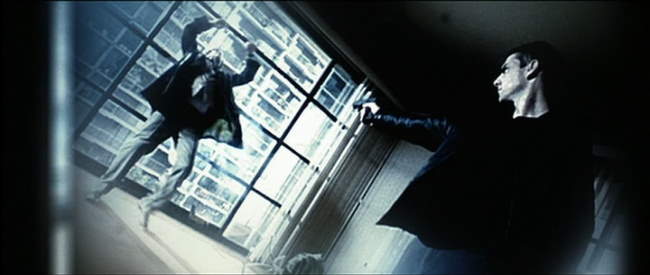
Anderton, plagued by the death of his son by an unknown assailant prior to the Precogs, has traditionally been the program’s biggest proponent. However, after learning of the Minority Report, he becomes concerned with the possibility that he has in fact been putting innocent people away. But unfortunately, his investigation into this matter has created powerful enemies. A new red ball vision is created, only this time Anderton finds out that HE is supposed to commit a murder in 36 hours. Convinced that he has been unfairly targeted, Anderton escapes from his former team and goes on a crusade to clear his name. His plight forces him to replace his eyes (used for retina scans at all security posts), and eventually takes him to the bottom of the Pilot Program’s seedy beginning.
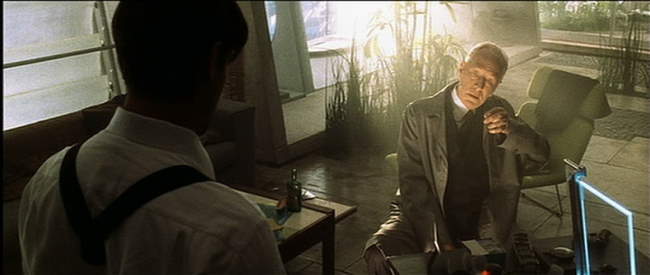
Story Issues : Nevermind the issue that the creepy hacker dude is able to jury-rig a vision scanning and extraction device faster than Scotty can fix a warp drive, Minority Report has a major issue with the technology that’s really never taken seriously – the issue of freewill. If precogs really can see into the future and determine that someone “will” murder their intended victim, this negates the ability of choice at that last instant of the murder. While this is eventually addressed (no spoilers), there is no rationale provided for why freewill was ignored. In the end we are left with believing that over-zealous law enforcement personnel were able to convince the entire country to take this approach. While this is a fine plot point, it would have been far more believable had their been some indication that they actually had to do a massive conving job.
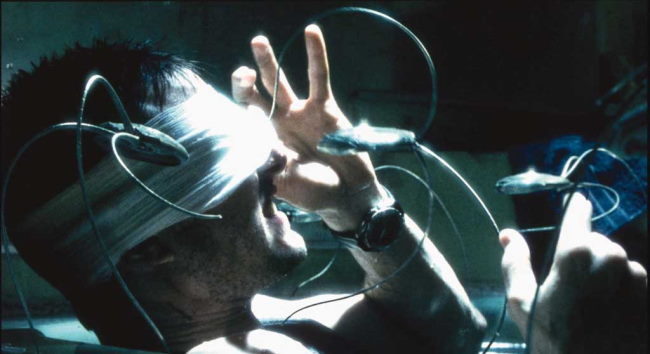
The Eyeball – the Ultimate Security Breach: The other issue with the story that really defies believability is that when John Anderton is caught, he is CONTINUALLY able to get back into the most secret areas of Police HQ by using his former eyeballs, which he keeps with him in a plastic baggie. Even though the police know he’s on the lamb, the apparently don’t feel the need to revoke Mr. Anderton’s security access privileges. This is all the more disbelievable considering EVERYTHING in society is apparently keyed off a retina scan. Sure, OK, perhaps one time they lapse on this, but three times??? Common Steven – you’re too good a story teller to let that one slide.
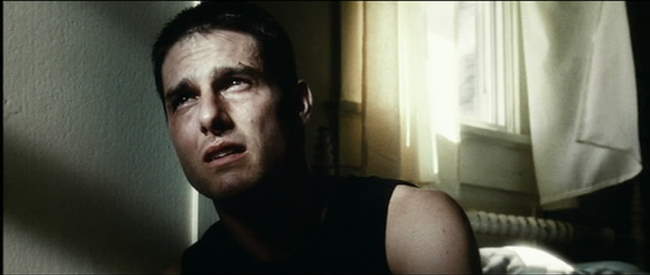
The Visuals: The visuals are sleek and well integrated, with some nice aqua and blue tones throughout. Interestingly, Spielberg usually goes with an overexposed type of shot to make it look almost as if one is looking at a dream sequence. Continually, we get white saturation dominating the shots. While this approach sounds weird, it ends up working wonderfully in adding to the mood of a cyberpunk film that has a massive focus on visions and dreams. As always, Spielberg gives us a plethora of truly unique visuals and mood shots. The best of the movie comes when Agatha
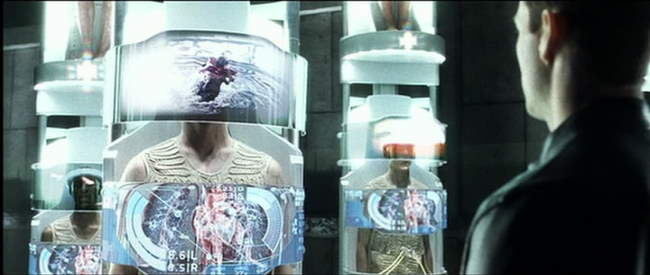
The FX: Minority Report consistently has absolute top-notch FX that adds interesting elements to the story. From the strange spider surveillance things, to the Boba Fett Police Podships, to the mixed modern cityscapes, the world of Minority Report comes off as a truly odd cyberpunked future. At some level, everyone seems to be living normal lives. Yet every now and then, we get a sense that the surveillance society has taken hold to the point that people have all just accepted it.
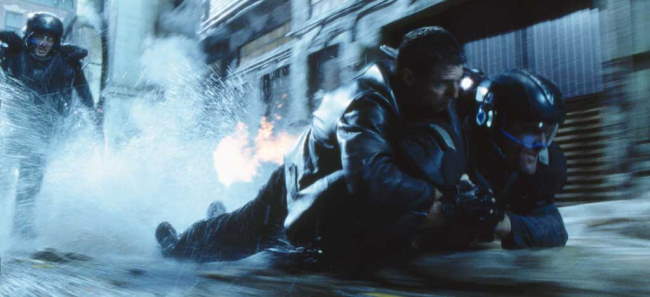
The Bottom Line: The overall mood and FX in Minority Report are terrific. The acting is great - Cruise has rarely been better, but also Von Sydow as the Police Director, Collin Ferrel as the scheming FBI agent, and Samantha Morton as the Precog are all terrific. The FX and sound If you buy the technology, chances are you give Minority Report at least a 9 or 10 star rating. Unfortunately, I did have problems buying some of this. Regardless, the story issues don’t take too much away from a very worthy cyberpunk film.
Page 2: More Screencaps–>>
~See movies similar to this one~
Year: 2003
Directed by: Jonathan Mostow
Written by: John D. Brancato & Michael Ferris (story & screenplay), Tedi Sarafian (story)
IMDB Reference
Degree of Cyberpunk Visuals: High
Correlation to Cyberpunk Themes: Medium
Key Cast Members:
Terminator: Arnold Schwarzenegger
T-X: Kristanna Loken
John Connor: Nick Stahl
Kate Brewster: Claire Danes
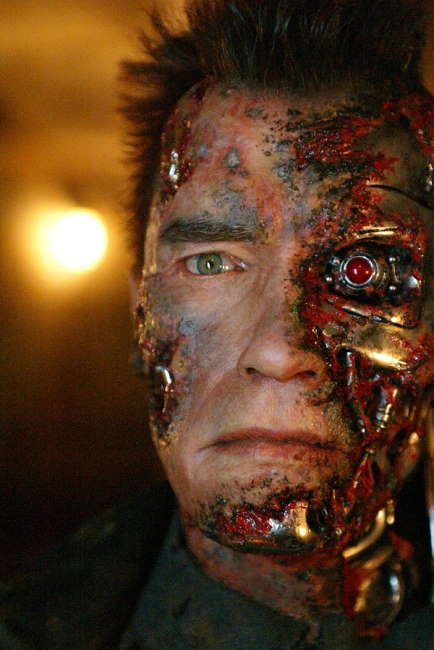
Overview: What happens if you take the original Terminator idea, morph it with T2, get rid of any semblance of a coherent, cool story, but add a really hot chick in leathers kicking butt to it? Answer: Terminator 3: Rise of the Machines! Director Jonathan Mostow really kicks the FX up a notch, but unfortunately, the story fades into more of a prop than the centerpiece it was in the first two movies. While the key cast members are all fine (terrific in the case of Lokken), they can only work with what they’re given.
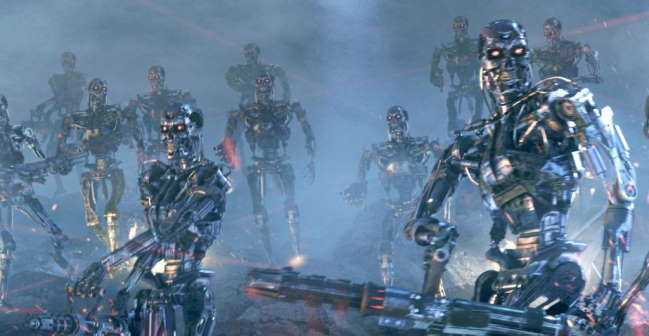
The Story: In Terminator 3, 10 years have passed since John and Sarah Conner destroyed Cyberdyne Systems and stopped the Skynet apocalypse. Unfortunately, it seems that the future is not what we make of it (As Desirina reminds us in the T2 comments), instead, fate is now predetermined. Why? Who knows…roll with it, buddy. You’ll get no well thought philosophical time travel notions here. Instead, the Terminator mystique is just that – a façade to get us to the juicy action sequences!
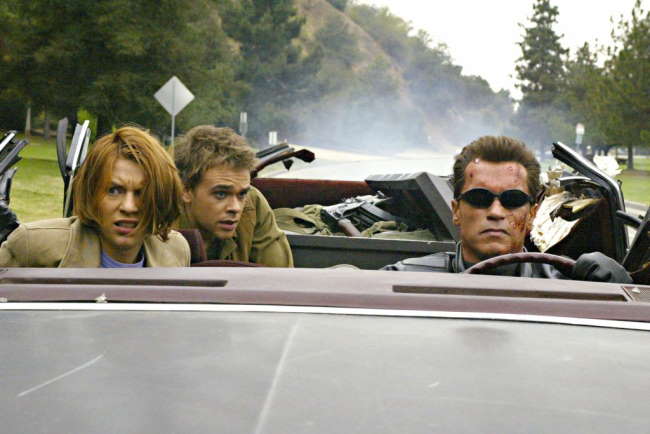
Over the years, John Conner (Nick Stahl) has turned into a drifter – he never really believed that the end of the world was abated, so he has spent his life leaving no clues as to his existence (no phones, bank accounts, and FORGET that damn phonebook!). He wrecks on his motorcycle, and due to his fear of hospital records, decides instead to break into a local veterinarian’s office and take some random medicine in the hopes that it’s a pain reliever (apparently, in the future time of 2003 the west has forgone local clinics that treat illegal aliens without recording their names and addresses). It just so has it that Conner has broken into a vet where Kate Brewster (Claire Danes), a former junior high fling of Conner’s, works.
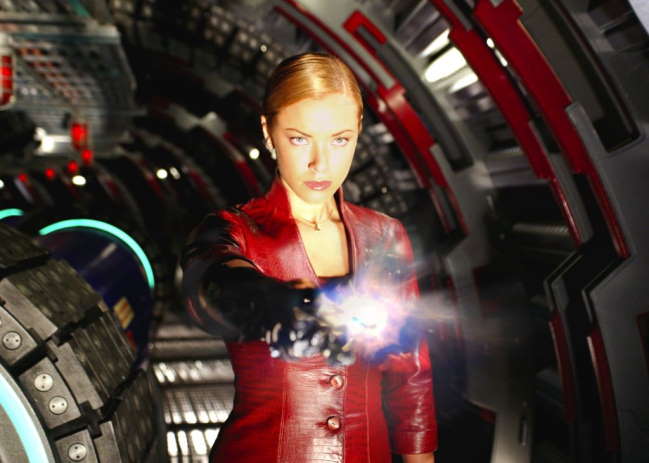
While this is going on, The TX (Kristanna Loken), or Terminatrix as Conner refers to her, arrives from the future. The new Terminatrix is nanotechnology enabled, and can control all computer networks and most electrically powered machines - in short, she’s a badass. Because Conner has all but disappeared, her mission is to bump off his lieutenants, and if possible, to then locate and terminate Conner. Arnold Schwarzenegger as the obselete CYberdyne Systems 101 model is once again captured in the future and dispatched in an attempt to save John Conner, and his future wife from the nuclear holocaust, and if possible, protect them from the Terminatrix.
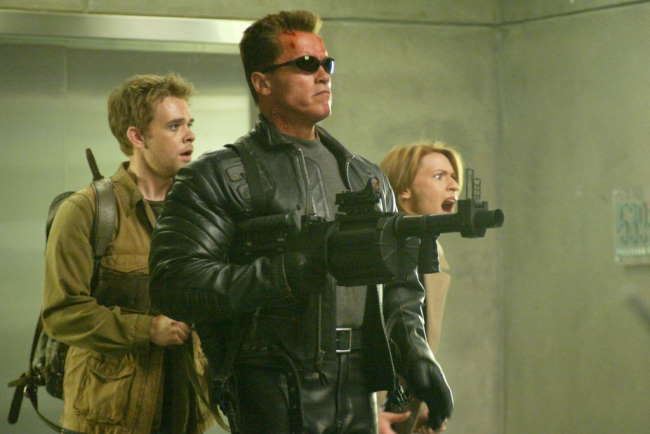
Philosophical Problems: I understand the desire to “go to the well” once more in the Terminator series, but it seems like they could have been a little more sophisticated in how they went about it. For instance, why, if Skynet is going to keep sending Terminators from the future, doesn’t it send them all back to 1984? Even a little throwaway line, similar to Star Trek’s magical matter-anti-matter converter, telling us that this isn’t possible would have helped this. Also, there’s the problem that Skynet’s grid was smashed in T1 – which was the whole purpose for the last ditched desparate attempt at a retroactive abortion. If the grid has been smashed (which if Skynet is an AI, what does this even mean?), how is it that Skynet can keep on producing newer Terminator models? Clearly, things are going all that badly for Skynet. I almost envision Skynet being in it’s “last throes” as similar to another conflict in today’s time.
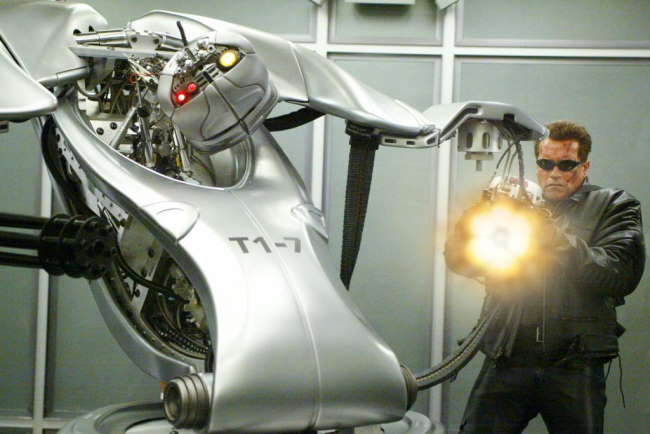
In T3, we get to see the first model Terminator.
More harmful than the problems above is the issue of fate being predetermined. Um, OK, sure, I suppose it could be, but couldn’t they have tried to justify this a bit more? The Original Terminator provided us a wonderfully nuanced time loop; Terminator 2 at least still kept a pretty solid story with the idea that the future is what we make of it. Terminator 3 basically says, “Fuck it. You’ll all screwed anyways, so lets just throw down!” And throw down they do.
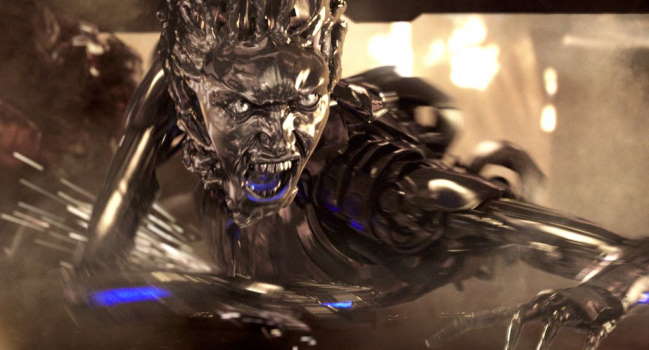
The FX: Although the story takes a significant hit in T3, the special effects do indeed rock in an over-the-top sort of fashion. I thought the truck-car race was a bit too over-done, but I LOVED the Terminatrix’s FX. And truly, Kristanna Lokken played her wonderfully. I loved her facial expressions and demeanor. She knew what the part was supposed to deliver (a hot android terminator chick kicking ass) and did it wonderfully. The FX surrounding her from beginning to end are reason enough to watch this movie.
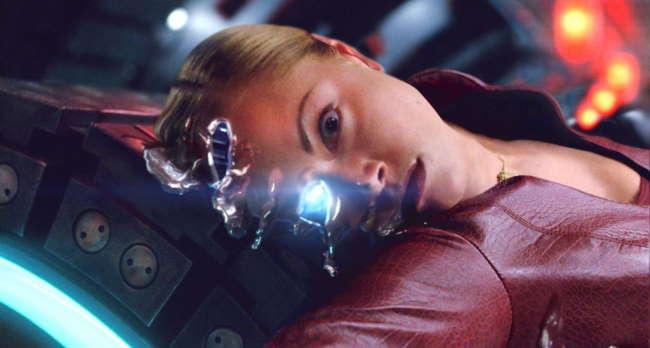
The Bottom Line: While this movie rates highly as a “hot chick kicking butt” flick, it suffers in comparison to its two predecessors as the ending to a trilogy. Terminator 3 certainly was enjoyable, but not in the sophisticated sense that the first or second one was. The sliding scale I see with this series is as follows: Terminator had an awesome story and pretty great visuals for its time; Terminator 2 delivered a very good story, and provided awesome visuals – the type that raise the bar on future movies; The third does away with the cool story but at least still delivers the visuals. In short, Terminator 3: Rise of the Machines is a bubble-gum chewing summer blockbuster, pure and simple. But on that level it works fine. However, based on the downward quality trend, if Abbot & Costello were still alive, I’d say that the next movie should be titled “Abbot and Costello Meet the Terminator.” Regardless, 5-6 stars is a reasonable place for a movie that delivers extremely well on the visuals but falls off on the story. In this case, 6 stars seems appropriate. Watch it for the FX and Kristanna Loken-Arnold battles, not for a continuation of the story.
~See movies similar to this one~
Year: 1991
Directed by: James Cameron
Written by: James Cameron & William Wisher Jr.
IMDB Reference
Degree of Cyberpunk Visuals: Very High
Correlation to Cyberpunk Themes: Medium
Key Cast Members:
The Terminator: Arnold Schwarzenegger
Sarah Conner: Linda Hamilton
John Conner: Edward Furlong
T-1000: Robert Patrick
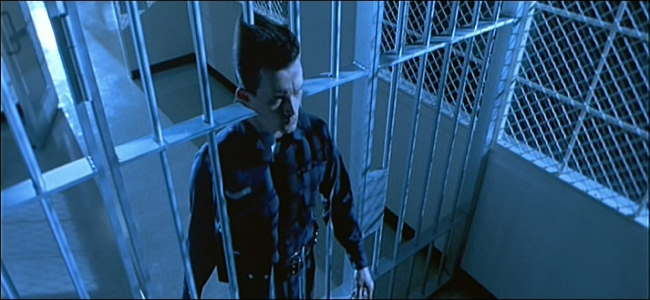
Overview: Often sequels are just made to cash in or earlier successes with a rehash of the existing story. To Cameron’s credit, he comes up with an entirely different take from the original Terminator movie, yet still maintains some level of believability to the story. Cameron certainly ratchets up the FX, but doesn’t forget the essentials that made us love the original (a well told story). Arnold Schwarzenegger returns as the Terminator, but this time he’s the good guy. Sarah Conner’s transformation from the girl next door to toughened soldier, willing to do anything to see to her son’s viability and stopping the enemy.
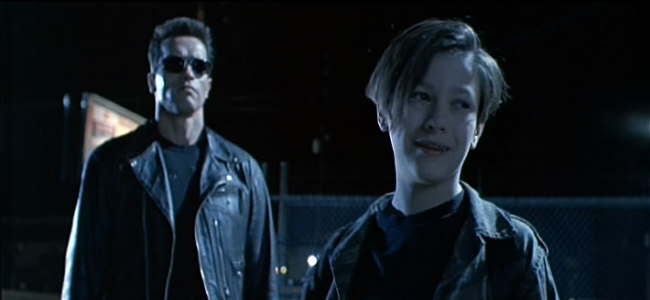
The Story: In Terminator 2: Judgement Day (T2), over 10 years have past since the events of the first movie, and the Skynet from the future has made one last attempt (um, well, until T3, that is – I believe the final last attempt will be Terminator versus Predators) to destroy John Conner. This time, they have skipped the “retroactive abortion” ploy, and are targeting him directly. This time, they are sending a more advanced unit – the T1000 – an android made out of liquid metal. The T1000 has the ability to copy virtually anything it touches, but prefers to assume the form of a police officer (Robert Patrick) to aid in its pursuit of John Conner.
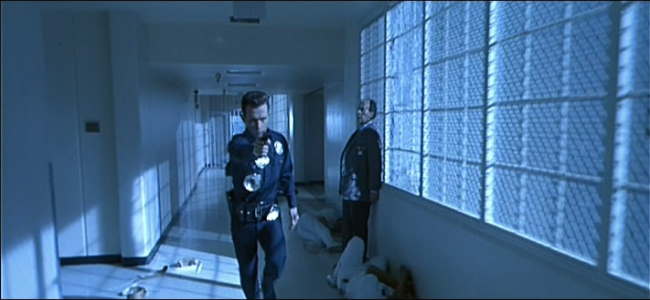
John Conner of the future, in a desperate attempt to save the gains made, captures, reprograms and sends back Cyberdyne Systems model 101 (Arnold Schwarzenegger) to protect John Conner in the past. His primary mission is to ensure John Conner’s survival by any means necessary. A secondary aspect of his programming states that he must take orders from John Conner.
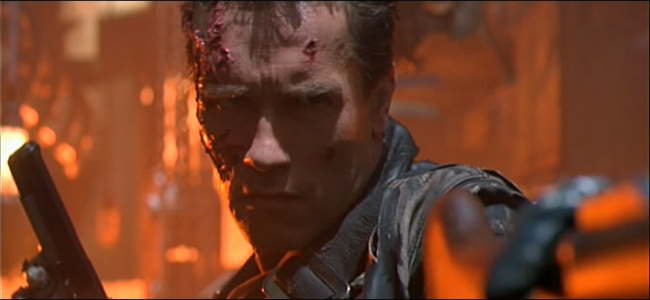
John Conner is currently living in a foster home, as his mother has been committed to an insane asylum by the good Doctor Silberman (Earl Boen). Now, disenchanted to learn that his mother has basically fed him a fantasy his whole childhood, he has become a troublesome youth. He spends his time stealing money from ATMs, jerking off with friends, and playing video games.
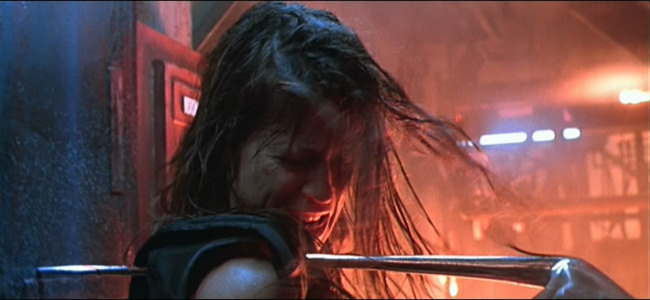
As the plot evolves, the familiar chase and pursuit feeling from the first movie returns, only this time we get the added benefit of Terminator on Terminator conflict. John Conner eventually hooks back up with his mother, and they decide to make an attempt to eliminate Cyberdyne Systems in the present, thus, eliminating the apocalyptic future that awaits the human race. Unfortunately, the T1000 has other plans.
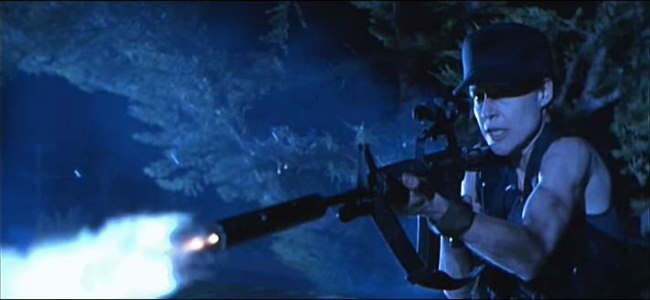
The Acting: The most impressive aspect of T2 is the personal training Linda Hamilton put in to make her transformation to a soldier absolutely believable. She really looks the part, and for a short time, almost comes across as a terminator-like powerhouse. Her acting is also spot on, as is Edward Furlong and Schwarzenegger. Robert Patrick puts in a serviceable job as the T1000, but still pales in comparison to Schwarzenegger’s character in the original. Joe Morton is also decent as Cyberdyne System’s top scientist, Dr. Miles Dyson.
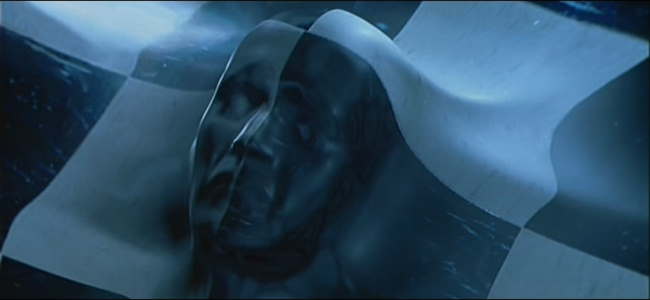
The FX: T2 is remembered for raising the bar on CG enhanced FX. Cameron transformed the T1000 into almost as large a phenomena as Schwarzenegger’s Terminator became in 1984. The liquid metal effects had the benefit of looking ultra-cool while not requiring the detail necessary for facial features. In this way, Cameron really played to the strength of the available technology. However, over time, as FX have continued to evolve, the impact of the T1000 has been significantly diminished, while the original Terminator is more embedded in our psyche than ever.
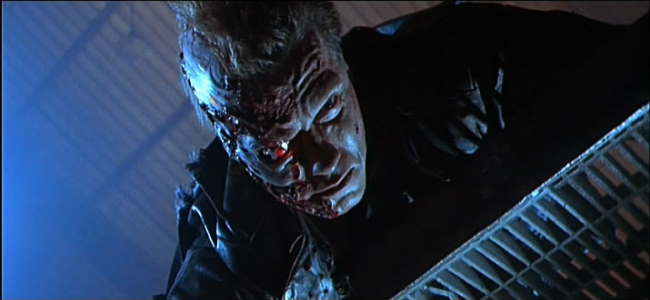
The Bottom Line: While T2 is a very well made film, personally, I still like the original lots better. Simply put, the movie is a very well made sequel, and still includes the best android fight on film. But in my mind it’s not nearly as sophisticated in terms of the whole Time Travel angle, and worse, it invalidates a key part of the original story – that nobody goes through after the first pairing. One wonders why they Skynet of the future didn’t just send the T1000 back to the same time as the first movie – then they’d have 2 Terminators pursuing Sarah Conner (or 3, 4, or 5 depending on how many Terminator movies we finally end up with). Still this is a minor point, and I know of many who disagree with me about the original being better.
T2 Page 2: More Screencaps–>>
~See movies similar to this one~
Year: 2002
Directed by: Si-myung Lee
Written by: Sang-hak Lee & Si-myung Lee
IMDB Reference
Degree of Cyberpunk Visuals: Low
Correlation to Cyberpunk Themes: Medium
Key Cast Members:
Sakamoto Masayuki: Dong-Kun Jang
Saigo Shojiro: Tôru Nakamura
Hye-Rin Oh: Jin-ho Seo
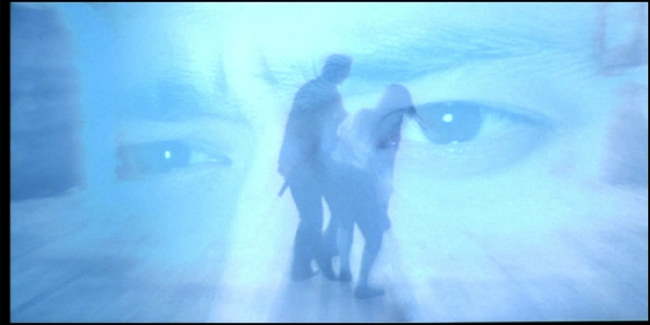
Overview: In yet another very well made Korean Sci-Fi movie, we have a terrific story, great acting, and a wonderfully unfolding secret that really adds to the suspense. 2009: Lost Memories is one of the best Time Travel movies out, and takes place almost completely within an alternate timeline. In this alternate reality timeline, Korea is a Japanese territory called Choson. The primary language of Choson is Japanese, and although the natives still speak Korean in private, they speak Japanese in the course of normal operations. Japan won WWII, and the atomic bombs were dropped on Germany. The Furei-Senjin (Choson Libration Army) are the last ones alive who know that the timeline has been tampered with, and will do whatever is necessary to set things right.
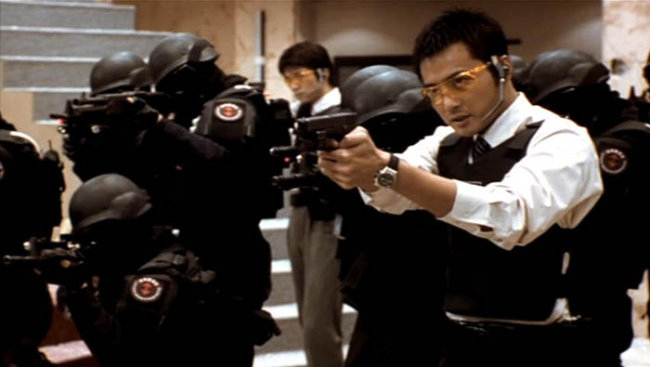
The Story: Sakamoto Masayuki and his partner and best friend, Saigo Shojirou are police officers living in Choson (a province owned by Japan that we know as Korea) who are investigating and confronting the terrorist organization called the Furei-Senjin. Sakamoto discovers that the Furei-Senjin have been after a crescent shaped stone called the Lunar Soul - an ancient artifact purported to have the soul of the moon in it. In pursuing the story, a number of different strands in Sakamoto’s life start to fall into place.
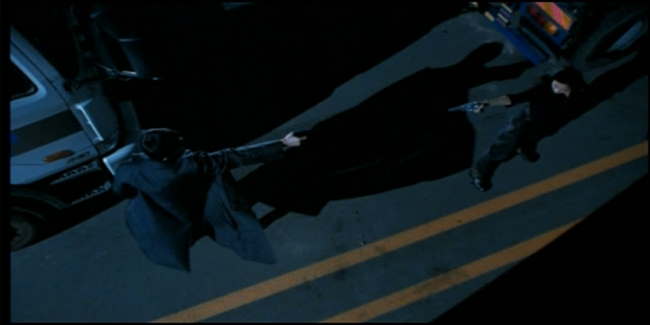
For most of his adult life, Sakamoto has a recurring dream about a beautiful woman he has never met - she has a crescent necklace, and in the dream, they shoot someone. Sakamoto knows he is in love with this woman, and, for some reason, thinks they are destined to be together. During the second confrontation with the Furei-Senjin, he meets this woman - it turns out that Oh Hae-rin (the woman from his dreams, played by Seo Jin-ho) is in fact a leader of the Furei-Senjin. She too feels the connection, and stops her followers from killing Sakamoto when they get the chance.
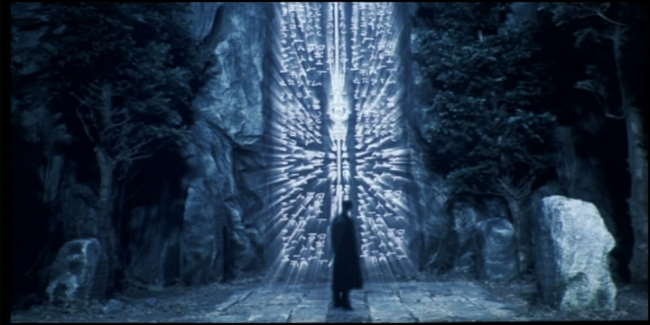
Through his investigation, Sakamoto discovers that back in 1909, in the area surrounding Harbin, there was an attempted assassination of Ito Hirobumi (http://en.wikipedia.org/wiki/Ito_Hirobumi), a prominent Japanese politician back than, and Japan’s first Resident General of Korea following the Russo-Japanese War (which Japan used to occupy Korea). This assassination was prevented by Inoue, an unknown soldier, who was later rewarded for his feat by becoming the second Governor. The Inoue Foundation has spent the last century collecting all artifacts from the 1909 time period.

In following the trail, Sakamoto learns too much, and is framed for the murder of a fellow police officer. Sakamoto eventually discovers that history was altered at that moment, and that Hirobumi was supposed to die that day, and that there never should have been an Inoue back in Harbin on that day. This leads him to the astonishing revelation that the Furei-Senjin are actually the last group alive aware of this tragedy, and that they are trying to restore the proper world timeline. As the movie develops, Sakamoto and his partner become enmeshed on opposite sides of this timeline struggle.
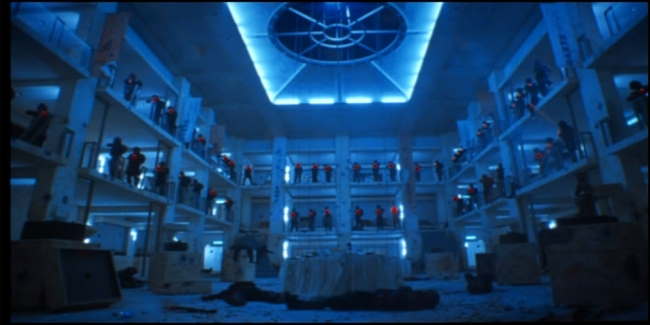
Cost of Entry For Understanding: There is a cost of entry to understanding 2009: Lost Memories. It helps if you recognize the difference between Japanese and Korean Characters. Japanese characters are pictoral in nature, whereas Korean characters look like boxes, half-boxes (L-shaped characters) and circles. This is significant especially at the beginning. The other important element is to know which language they are speaking. Sakamoto is Korean, whereas his partner, Saigo Shojirou is Japanese. The importance and meaning of the scenes is often given away when they switch over to speaking Korean (most of the movie’s “public” scenes are in Japanese). For instance, when Sakamoto is with his uncle, he ALWAYS speaks Korean. Also important to know is the latent hatred that still exists in Korea towards Japan for the time they were occupied (up until WWII). To Koreans, this movie will come off as far more emotional than for foreigners.
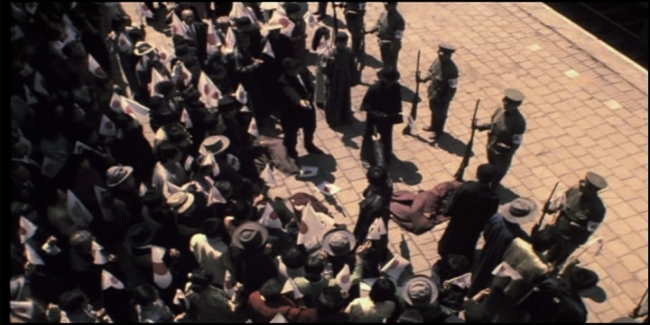
The Bottom Line: 2009: Lost Memories is a very intelligent Korean sci-fi film. I include it as cyberpunk primarily for the wonderfully done time-travel theme done in the very near-future. Te intense confrontation between the best friends that occurs as this movie develops is just terrific. The visuals are all high-tech current visuals though - they are not futuristic in most of the cyberpunk sense. But the world they create is cyberpunk in the sense that it depicts a reality changed by a future traveler to a past time. Also interesting is the notion, that even during a “time-shift” souls might potentially “know” something is amiss.
~See movies similar to this one~
Year: 1984
Directed by: James Cameron
Written by: James Cameron, Gale Anne Hurd
IMDB Reference
Degree of Cyberpunk Visuals: High
Correlation to Cyberpunk Themes: Very High
Key Cast Members:
The Terminator: Arnold Schwarzenegger
Kyle Reese: Michael Biehn
Sarah Connor: Linda Hamilton
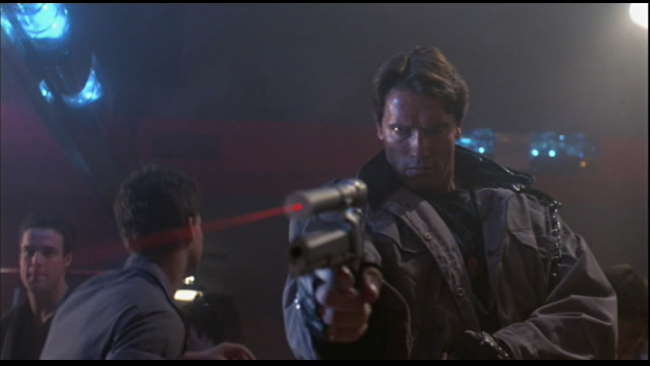
“The Terminator’s an infliltration unit…part man - part machine. Underneath it’s a hyper-alloy combat chassey…microprocessor controled…fully armored - Very tough. But outside its living human tissue…flesh…skin…hair…blood - grown for the cyborgs.”
Overview: No movie has been more imitated in cyberpunk than the Terminator. While most of the imitations have been grade “B” shlock films, they attest to the intense effect that the Terminator had on our consciousness. This film is legendary, and easily ranks in the top 5 or 6 most influential cyberpunk films ever created (Blade Runner, Metropolis, Ghost in the Shell, and The Matrix being the other four, and Alien if you consider that cyberpunk). Terminator is a film with terrific replay value – so much so that I’m guessing all of you have seen it enough times that I don’t need to bore you with a plot overview. With a 6.4 million dollar production budget, this is far from a big-budget blockbuster. The reason it’s stood the test of time, and in fact comes across as a block buster, comes down to incredible execution by beginning film maker James Cameron and cast.
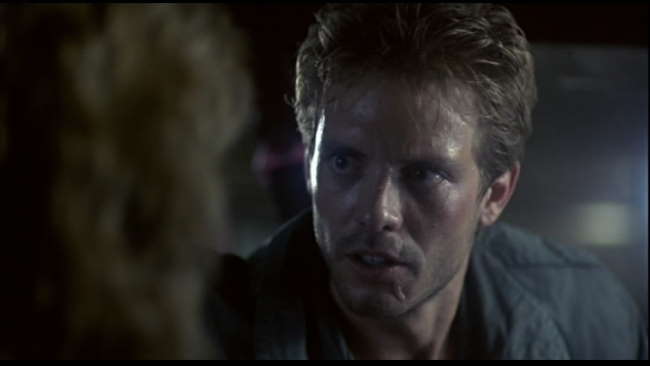
“I’m here to help you…I’m Reece - Sargeant Tech Com BN38416 - assigned to protect you…You’ve been targeted for termination.”
The Acting: From Schwarzenegger’s eery style of acting, to Linda Hamilton’s growth on screen from a shy teen to tough mother of mankind, to Michael Biehn’s tour-de-force performance from beginning to end, the leads flat out carry this movie. That said, the background characters are all terrific, including Bill Paxton at the beginning (“Fuck you, asshole!”), to Paul Winfield (Lieutenant Traxlet), Lance Henriksen (Detective Vukovich) and psychologist, Earl Boen. There are too many memorable scenes to relate here, but the real strength of the acting in this case comes more in expressions and setting mood than it does in delivering the lines, although Beihn’s narrative in particular is riviting.
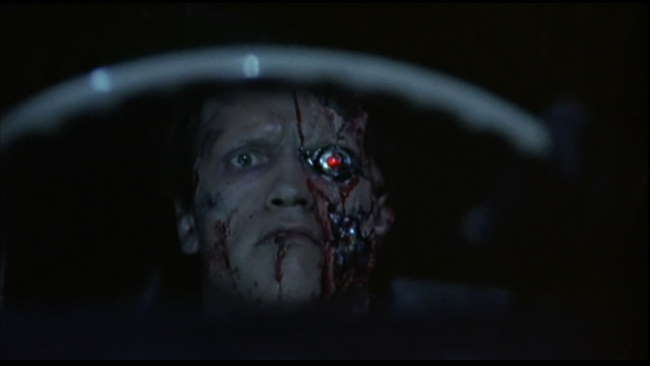
The 600 series had rubber skin. We spotted them easy. But these are new…they look human. Sweat…bad breath…everything…very hard to spot.
Reece’s character does straight exposition to explain the story, which is usually a lousy delivery method. However, the mix of action and exposition just works. The dialogue was terrific, and Reece delivered it in the context of a high-tension chase. During this, Hamilton’s character literally transforms from a vulnerable, girl-next-door to a hard-edged, do-what’s-necessary, take charge kind of gritty leader. Their chemistry is terrific. They have a shy tension, that eventually turns into an intense, believable love affair. It’s kind of amazing that the studio originally wanted Arnold Schwarzenegger to play Reece. Schwarzenegger as the Terminator provides us one of the all time characters in all of scifi. He is the ultimate warrior android, and has been imitated far too many times to count.
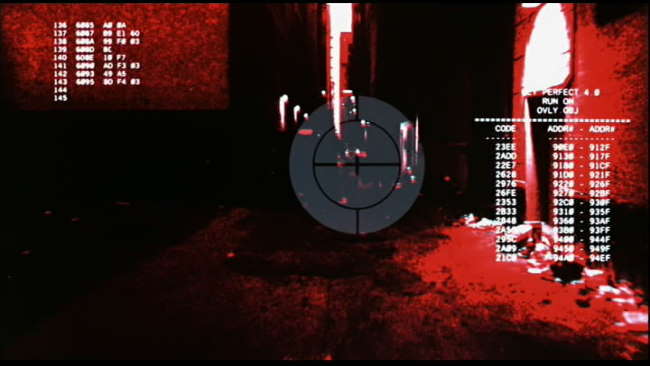
“There was a nuclear war…about a few years from now…all this….this whole place…its gone…just gone… the survivors…here…there…nobody knew how it started…it was the machines, Sarah.”
The Pacing: The Terminator’s pacing is probably the most copied aspect of this film. The Terminator, from the very first scene to the very last is a chase movie. The tension goes from high to massively high to short breathers, back to massively high tension. You literally feel tired after watching this. While this doesn’t seem unusual now, back in the early 80s, The Terminator took the hectic fast pacing of Raiders of the Lost Ark and adapted it to a full scale chase flick. The real magic here was Cameron’s ability to embed a fascinating story into the chase, while changing the bad guy from human to robot to basically add a completely new feeling to the chase.
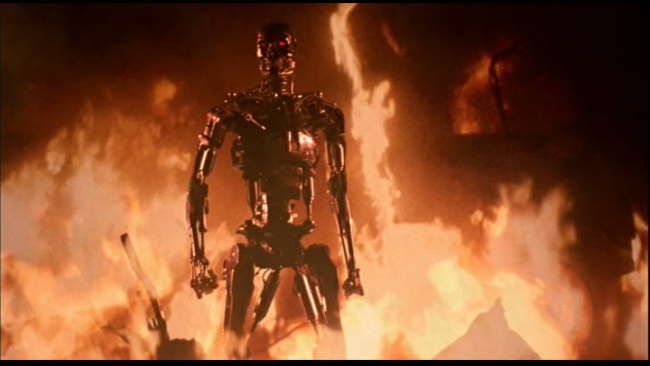
“You still don’t get it, do you…He’ll find her. That’s what he does! That’s ALL he does! You can’t stop him. He’s wade through you, reach down her throat and pull her fucking heart out!”
The FX: For the budget, Terminator’s FX far exceeded anything that should have been possible. The Endoskeleton, made up of miniatures, models and stop-motion animation, is now part of movie lore. The car chase scenes still look terrific, as do the explosions. The near-future dystopic scenes are completely riveting, especially the flying HKs! However, a few of the model shots of Arnold do look slightly dated now (most noticeably when Arnold takes out his eye).

“In the few hours we had together, we loved a lifetime’s worth.”
The Score: Brad Fiedel’s percussive, driving beat that creates an industrial masterpiece that absolutely nails the feeling of The Terminator. You can still here the “dun-dun dun dun-dun” beat and IMMEDIATELY get teleported back to that sense ominous doom of the future that the Terminator portends.
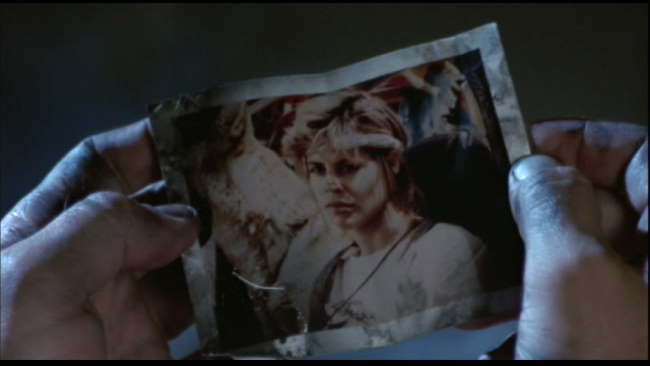
“That was a good hussle, kid.”
Time Travel: The Terminator provides us one of the best time travel movies in cinema. It’s intelligently done in a coherent way that really sets the picture moving. But the real majesty is in the photograph (see above). I LOVE the picture and everything it represents. There, in that one image, we get the entire love affair of Sarah and Reece, John’s struggle relating to someone he knows to be his father (but who cannot know in return), Sarah’s future journey, and a wonderful mind fuck to boot! The placement of the time travel elements at the beginning and ending of the story really do add impact to its meaning.
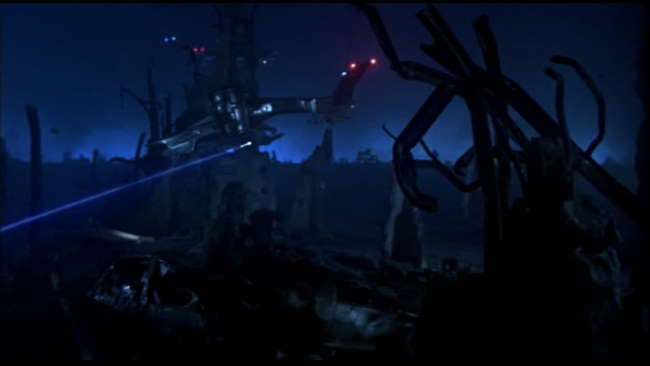
“You stay down by day, but at night you can move around. You still have to be careful because the HK’s use infrared…they’re not to bright…John taught us ways to dust them…”
Guerilla Filmaking: In watching the most awesome extras on special edition DVD, it’s clear that the Terminator was way over-ambitious (thank God!). In post-production, it was clear to Cameron that a number of additional unfunded scenes were needed in order to make a complete picture. Cameron used his weekly director’s pay to pay skeleton crews to go out and do additional shots – often which used incredibly low-end effects. For instance, the body bag used at the end was actually Cameron’s suit bag. The scene at the beginning where Arnold breaks into the station wagon was filmed with just him and Cameron, worrying about the police seeing them as Arnold breaks the car window (Arnold’s clothes for the scene were in his trunk – he had to change in the car!). More incredibly, the last shot of the Terminator, where the red eye slowly fades, was shot later – the smoke you see there was someone breathing cigarette smoke on the eye! In short, everyone gave blood, sweat and tears to make sure this film looked as good as it did.
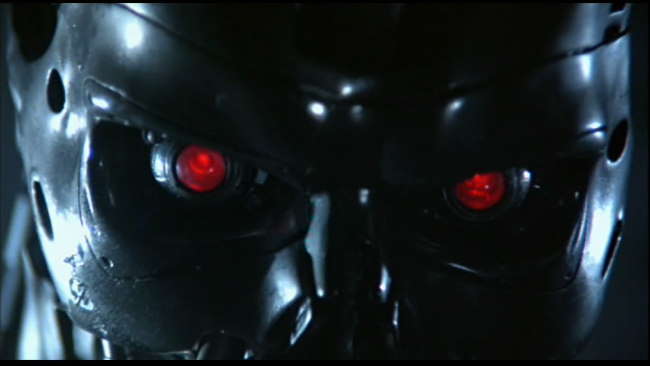
“That terminator is out there…it can’t be bargained with…it can’t be reasoned with. It doesn’t feel pity, or remorse…or fear. And it absolutely will not stop - EVER - until you are dead!”
The Bottom Line: The mood, energy and intensity of The Terminator oozes from every pore of the first shot to the last. If you are one of the very few who has not experienced this movie, you’re in for a treat! If you’ve seen it before (many times even), chances are you’ll be seeing it again. The Terminator definitely deserves a place of honor in the pantheon of cyberpunk flicks. One problem this film does give from a categorization perspective - they call the Terminator a cyborg, but he is really an android (even Cameron calls him this on the extras). The definition of a cyborg implies an augmented human, not an android covered with human tissue. I give it 9 stars as a movie, but add an additional star for its overall impact on film making.
Terminator Page 2: More Screencaps–>>
~See movies similar to this one~
Year: 1995
Directed by: Mikio Hirota
Written by: Mikio Hirota
Degree of Cyberpunk Visuals: Low
Correlation to Cyberpunk Themes: Low
Key Cast Members:
The Terminatrix: Kei Mizutani

Overview: In pursuit of me desire to see all cyberpunk-like films out, I was seduced into getting this flick. Terminatrix is basically the original terminator movie remade with in naked Japanese chicks. In Terminatrix’s vision of the future, an evil artificial intelligence has taken over the human race, and sex is fully regulated to stop overpopulation. But one woman, seeing the injustice in this system, rebels (This is the John Conner stand-in) and starts the resistance by convincing everyone to have massive orgies of their own free choosing. To stop this, the AI sends a hot Japanese cyborg chick - the Terminatrix, played by Japanese Exploitation Queen Kei Mizutani, back in time to have find the father of the chick who leads the orgy resistance. The Terminatrix has the ability to make people impotent by fucking them and breaking their dicks off (this also seems to kill them as well). To find our future heroine’s father, the Terminatrix doesn’t know his middle name, so, um, she goes through the phone book in order to kill the male Sarah Conner stand-in. In an attempt to stop this foul plot, the resistance is able to send a single hot naked human chick (Reece’s replacement - I must say, she looks a lot better than Reece!) is sent back to stop her and to save the father (Sarah Conner substitute). Our Reece substitute can tell who Terminatrix is by checking out her ass, so she is forced to go around lifting up all the women’s skirts!
Yes, this plot is as cheesy as they come, but let me be clear about this - Terminatrix is a frickin RIOT!!! Why, you ask? On an extremely twisted level, Terminatrix so closely follows the Terminator story that you’re continually busting out in laughter. On top of this, both the writing and production values are far above what you’d normally expect from a movie such as this. Literally, if you’re as familiar with that movie as I am, and have a soft spot for over-the-top cheesefests, you will LOVE this movie.
The terminatrix’s cyborg vision lines are a riot. When having sex (they don’t get explicit here, just frontal nudity) with her victems, the Terminatrix’s “terminator screen” messages show things like, “Not cuming fast enough” or “Whip him.”. When the Reece chick finds the future father, she says, “The future of humanity depends on your penis!” At least he has the good sense to shut the door on her. Also, if Terminatrix’s future prognostication is any guide, the future is tailor-made for male chauvinists. In this “dystopia,” a computer calls you to have sex with random chicks - but here’s the bad part - you have to lay down while they to all the work! Hmm…come to think of it, I can probably imagine worse computer-dominated future scenarios than the one that prompted the revolution.
Funniest scene Hands down, the bathroom cyborg self-repair scene is a riot! You know the one I’m talking about - where Arnold has to fix up his face and stuff? In this version, the Terminatrix has been shot six times in her primary weapon (her vagina), and has to repair it. While rolling her eyes, she forces six bullets to come out of her vagina (they don’t show this other than by the dropping of bullets), then she recharges herself by putting electricity through her nipples. To make final repairs, she fixes herself down below by sitting on a mechanical dildo! In watching this, all you can say is “My God, what a bizarre flick!”
It Matters Where you Purchase This: IMDB doesn’t even have a listing for Terminatrix, so one would think its not easy to come by. At the time of this review, you can purchase it for $27 bucks at Amazon. While funny, $27 bucks is about least $18-20 more than you would want to pay for something like this. But you’re in luck as Deepdvddiscount has it for $5.99! That’s about as large a jump as I’ve seen in available DVD prices.
The Bottom Line Again, I’m rather shocked that Terminatrix has relatively decent production values. The acting isn’t bad either, so much so that it’s like they made a serious attempt at this! I didn’t attempt the dubbing track (I almost never do), but I’m guessing it’s something to stear away from. All in all, Terminatrix is a very fun entry into the cyberpunk (facade) soft-core porn market. And while this clearly isn’t cyberpunk, it is definitely a cyberpunk parody (of the Terminator). Fair warning - this movie will make you laugh out loud - it will not get you in the “mood.”
And my apologies for the lack of screencaps. I honestly tried to take screencaps but it was a waste of time, as all the cool scenes had nudity in them.
~See movies similar to this one~
Tags: cyberpunk movie review Terminatrix
Year: 1992
Directed by: Geoff Murphy
Written by: Robert Sheckley (Novel), Steven Pressfield et al. (Screenplay)
IMDB Reference
Degree of Cyberpunk Visuals: Medium
Correlation to Cyberpunk Themes: Medium
Key Cast Members:
Alex Furlong: Emilio Estevez
Victor Vacendak: Mick Jagger
Julie Redlund: Rene Russo
Ian McCandless: Anthony Hopkins

Overview: No, this is NOT a great movie, but I love the Rolling Stones, so sue me!
In Freejack, the earth’s environment has become severely damaged, to the point that most people suffer some form of illness. But technology has advanced to the point that someone’s consciousness can be transferred from one person to another. Also, a version of time travel, where a body can be taken forward to the “present” (2009), while risky, has become possible. Now, bounty hunters from the near future raid the past for perfect bodies with flatlined brains to bring forward in time to sell to the highest bidder. Emilio Estevez plays a race car driver who crashes and dies in a spectacular way on live TV back in 1992, but just before he dies, is taken to the future by a shady character played by Mick Jagger.
The Bottom Line: Freejack loses out incredibly on believability, as does it for its insanely fast prediction for both the destruction of the earth and the relatively rapid speed of technology progression. In retrospect, maybe this movie should have taken place in 2049 instead. One wonders Murphy took a cast with Emilio Estivez, Rene Russo and Anthony Hopkins and then churned out something so cheesy. It’s movies such as Freejack that gave cyberpunk films a poor quality image by the early 90s. Still, Jagger is pretty fun in this, as is the rest of the cast. As long as you turn off your brain, you should enjoy some decent cyberpunk visuals here.
EDIT: ETM reminds me in the comments below that Freejack also does bring up an interesting question that needs consideration: if technology gives life to a person, does the one who owns the technology own that life? This alone bumps it up to the “medium” catagory in the cyberpunk themes.
~See movies similar to this one~
Tags: cyberpunk movie review Freejack
|









































































